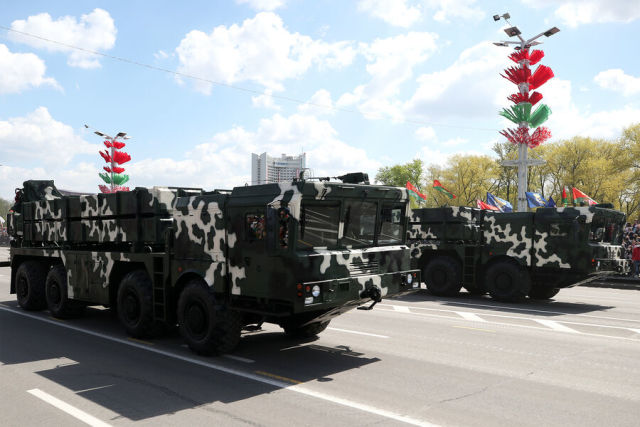Russia can buy the longest-range MLRS in Europe The American HIMARS systems supplied by the APU hit 300 kilometers, the Russian MLRS "Hurricane", "Tornado" and "Tornado" - from 35 to 120 kilometers.
According to Military Watch, the Armed Forces of the Russian Federation can purchase Belarusian "Polonaises" using Chinese missiles with a radius of destruction like HIMARS as an alternative to their systems. "Newspaper.Ru" tells how they can be used in a special operation and what is needed to launch a joint production.
The publication Military Watch reported that Russia can order Polonaises from Belarus - the longest-range multiple launch rocket systems in Europe. They use Chinese A-200 missiles of 301-mm caliber, the radius of destruction is up to 300 kilometers.
"The updated MLRS Polonaise, which is produced by Belarus, is a copy of the Chinese NORINCO ARS system, intended for export sale," he told the newspaper.Ru" military expert Alexey Leonkov. - The Chinese military was able to endow this system with a sufficiently high accuracy, the deviation from the target does not exceed 50 meters. With a volley fire of eight missiles, this is a fairly high indicator, which allows you to destroy both the enemy's open force and protected objects in the deep rear.
There is a small feature in the combined guidance system, which is inertial and requires GPS satellite correction. Russian MLRS are melee weapons, sometimes the enemy's coordinates issued by intelligence are sufficient, although navigation aids and data obtained from drones are used. This is comparable to the defeat of Russian operational-tactical complexes, which are "sharpened" for such a guidance system. This is how the missiles of the Avangard complexes, and cruise "Calibers", and hypersonic "Daggers" work. "Polonaises" can also be embedded in this structure and used with great precision."
In the MLRS "Polonaise", the Belarusian component is the chassis of the MZKT-7930 tractor of the 8x8 wheel formula with a load capacity of up to 25 tons. A similar base is used for the Russian Iskander missile defense systems, the Bal, Bastion, Clab-M, and the Hurricane-1M MLRS. That is, this eight-axle tractor is well known to the Russian army.
Azerbaijan purchased Belarusian MLRS "Polonaise" in 2018. According to the Azerbaijani Defense Ministry, 10 sets of MLRS have been adopted by the army of the republic. According to local media, Baku considered the "Polonaises" as a response to the Iskander missile defense system, which are in service with the Armenian army.
"During the Armenian-Azerbaijani conflict, the use of "Polonaises" was somehow muffled in the newspapers. The combat effectiveness of this MLRS remains rather in the theoretical field. After all, "Polonaises" are the fruit of interstate cooperation between China and Belarus. Moreover, the main component is Chinese. A legitimate question is whether it is possible for Russia to buy Chinese MLRS exactly what is in the original version? Chinese missiles on Chinese chassis. Or a variant of cooperation, when Chinese missiles on Russian chassis, say, Bryansk automobile plant.
Here we are entering on shaky ground related to the actual Chinese policy and practice of arms trade. If, for one reason or another, direct arms deals between the Russian Federation and the PRC are impossible, the Belarusian option remains the only possibility of this kind. However, here we again run into supply/demand. What capacities does Minsk have for the production of "Polonaises"? And in what time frame will he be able to make the transition from exhibition samples to conveyor production?" - said Alexander Zimovsky
The Belarusian army has 6 MLRS "Polonaise", they are accompanied by a number of Chinese A-200 missiles of 301-mm caliber. American analysts in recent publications suggest that Minsk may go to the joint production of such jet systems with Moscow. There should also be a third party in the project - China as a supplier of missiles.
"Such an option is not excluded," he told the newspaper.Ru" military observer Vladislav Shurygin. - There is an obvious benefit for all participants of the transaction. Belarus is resuming production of a combat wheelbase at MAZ, China is sending its missiles, of which they have an abundance, Russia is receiving finished products with improved characteristics, which it can use instead of more expensive tactical missiles. Taking into account the well-established production process, the "Polonaise" of such an assembly may well sound in Ukraine this year. I do not exclude that this system will be able to use the Russian Smerch-S missile system with a caliber of 300 millimeters.
Victor Sokirko

